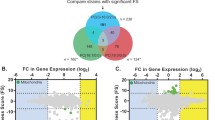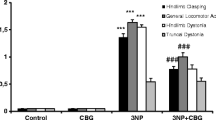Abstract
Acetyl-l-carnitine (ALC) is a naturally occurring substance that, when administered at supraphysiological concentration, is neuroprotective. It is a molecule of considerable interest for its clinical application in various neural disorders, including Alzheimer’s disease and painful neuropathies. Suppression subtractive hybridization methodology was used for the generation of subtracted cDNA libraries and the subsequent identification of differentially expressed transcripts in the rat brain after ALC treatment. The method generates an equalized representation of differentially expressed genes irrespective of their relative abundance and it is based on the construction of forward and reverse cDNA libraries that allow the identification of the genes which are regulated by ALC. We report that ALC treatment: (1) upregulates lysosomal H +/ATPase gene expression and (2) downregulates myelin basic protein gene expression. The expression of these genes is altered in some forms of neuronal ceroid lipofuscinosis (NCL) pathologies. In this case, ALC might rebalance the disorders underlying NCL disease represented by a disturbance in pH homeostasis affecting the acidification of vesicles transported to lysosomal compartment for degradation. This study provides evidence that ALC controls genes involved in these serious neurological pathologies and provides insights into the ways in which ALC might exert its therapeutic benefits.



Similar content being viewed by others
References
Mole SE, Williams RE, Goebel HH (2005) Correlations between genotype, ultrastructural morphology and clinical phenotype in the neuronal ceroid lipofuscinoses. Neurogenetics 6:107–126
Mazurkiewicz JE (1991) Ubiquitin deposits are present in spinal motor neurons in all stages of the disease in the motor neuron degeneration (Mnd) mutant of the mouse. Neurosci Lett 128:182–186
Messer A, Plummer J (1993) Accumulating autofluorescent material as a marker for early changes in the spinal cord of the Mnd mouse. Neuromuscul Disord 3:129–134
Pardo CA, Rabin BA, Palmer DN, Price DL (1994) Accumulation of the adenosine triphosphate synthase subunit C in the mnd mutant mouse. A model for neuronal ceroid lipofuscinosis. Am J Pathol 144:829–835
Rowan SA, Lake BD (1995) Tissue and cellular distribution of subunit c of ATP synthase in Batten disease (neuronal ceroid-lipofuscinosis). Am J Med Genet 57:172–176
Pearce DA, Carr CJ, Das B, Sherman F (1999) Phenotypic reversal of the btn1 defects in yeast by chloroquine A yeast model foe Batten disease. Proc Natl Acad Sci U S A 96:11341–11345
Katz ML, Rice LM, Gao CL (1997) Dietary carnitine supplements slow disease progression in a putative mouse model for hereditary ceroid-lipofuscinosis. J Neurosci Res 50:123–132
Bertamini M, Marzani B, Guarneri R, Guarneri P, Bigini P, Pennini T, Curti D (2002) Mitochondrial oxidative metabolism in motor neuron degeneration (mnd) mouse central nervous system. Eur J Neurosci 16:2291–2296
Bieber LL (1988) Carnitine. Annu Rev Biochem 57:261–283
Nalecz KA, Miecz D, Berezowski V, Cecchelli R (2004) Carnitine: transport and physiological functions in the brain. Mol Aspects Med 25:551–567
Beal MF (2003) Bioenergetic approaches for neuroprotection in Parkinson’s disease. Ann Neurol 53:39–48
Virmani A, Binienda Z (2004) Role of carnitine esters in brain neuropathology. Mol Aspects Med 25:533–549
Manfridi A, Forloni GL, Arrigoni-Martelli E, Mancia M (1992) Culture of dorsal root ganglion neurons from aged rats: effects of acetyl-l-carnitine and NGF. Int Dev Neurosci 10:321–329
Bertoni-Freddari C, Fattoretti P, Casoli T, Spagna C, Casell U (1994) Dynamic morphology of the synaptic junctional areas during aging: the effect of chronic acetyl-l-carnitine administration. Brain Res 656:359–366
Castorina M, Ferraris L (1994) Acetyl-l-carnitine affects aged brain receptorial system in rodents. Life Sci 54:1205–1214
Pettegrew JW, Levine J, McClure RJ (2000) Acetyl-l-carnitine physical-chemical, metabolic, and therapeutic properties: relevance for its mode of action in Alzheimer’s disease and geriatric depression. Mol Psychiatry 5:616–632
Seidman MD, Khan MJ, Bai U, Shirwany N, Quirk WS (2000) Biologic activity of mitochondrial metabolites on aging and age-related hearing loss. Am J Otol 21:161–167
Calò LA, Pagnin E, Davis PA, Semplicioni A, Nicolai R, Calvani M, Pessina AC (2006) Antioxidant effect of l-carnitine and its short chain esters relevance for the protection from oxidative stress related cardiovascular damage. Int J Cardiol 107:54–60
Gilbert-Barness E (2004) Metabolic cardiomyopathy and conduction system defects in children. Ann Clin Lab Sci 34:15–34
Traina G, Valleggi S, Bernardi R, Rizzo M, Calvani M, Nicolai R, Mosconi L, Durante M, Brunelli M (2004) Identification of differentially expressed genes induced in the rat brain by acetyl-l-carnitine as evidenced by suppression subtractive hybridisation. Mol Brain Res 132:57–63
Traina G, Bernardi R, Rizzo M, Calvani M, Durante M, Brunelli M (2006) Acetyl-l-carnitine up-regulates expression of voltage-dependent anion channel in the rat brain. Neurochem Int 48:673–678
Diatchenko L, Lau Y-F-C, Campbell A-P, Chenchik A, Moqadam F, Huang B, Lukyanov S, Lukyanov K, Gurskaya N, Sverdlov E-D, Siebert P-D (1996) Suppression subtractive hybridization: a method for generating differentially regulated or tissue-specific cDNA probes and libraries. Proc Natl Acad Sci U S A 93:6025–6030
Cao W, Epstein C, Liu H, DeLoughery C, Ge N, Lin J, Diao R, Cao H, Long F, Zhang X, Chen Y, Wright P-S, Busch S, Wenck M, Wong K, Saltzman AG, Tang Z, Liu L, Zilberstein A (2004) Comparing gene discovery from Affimetrix GeneChip microarrays and Clontech PCR-select cDNA subtraction: a case study. BMC Genomics 5:26
Munir S, Singh S, Kaur K, Kapur V (2004) Suppression subtractive hybridisation coupled with microarray analysis to examine differential expression of genes in virus infected cells. Biol Proced Online 6:94–104
Kasper D, Planells-Cases R, Fuhrmann JC, Scheel O, Zeitz O, Ruether K, Schmitt A, Poet M, Steinfeld R, Schweizer M, Kornak U, Jentsch TJ (2005) Loss of the chloride channel CIC-7 leads to lysosomal storage disease and neurodegeneration. EMBO J 24:1079–1091
Arata Y, Nishi T, Kawasaki-Nishi S, Shao E, Wilkens S, Forgac M (2002) Structure, subunit function and regulation of the coated vesicle and yeast vacuolar (H(+))-ATPases. Biochim Biophys Acta 1555:71–74
Mellman I (1992) The importance of being acid, the role of acidification in intracellular membrane traffic. J Exp Biol 172:39–45
Holopainen JM, Saarikoski J, Kinnunen PKJ, Jarvela I (2001) Elevated lysosomal pH in neuronal ceroid lipofuscinosis (NCLs). Eur J Biochem 268:5851–5856
Chattopadhyay S, Muzaffar NE, Sherman F, Pearce DA (2000) The yeast model for batten disease, mutations in btn1, btn2, and hsp30 alter pH homeostasis. J Bacteriol 182:6418–6423
Sun-Wada G-H, Wada Y, Futai M (2003) Lysosome and lysosome-related organelles responsible for specialized functions in higher organisms, with special emphasis on vacuolar-type proton ATPase. Cell Struct Funct 28:455–463
Messer A, Plummer J, MacMillen MC, Frankel WN (1995) Genetics of primary and timing effects in the mnd mouse. Am J Med Genet 57:361–364
Katz ML, Siakotos AN (1995) Canine hereditary ceroid-lipofuscinosis, evidence for a defect in the carnitine biosynthetic pathway. Am J Med Genet 57:266–271
Siakotos AN, Hutchins GD, Farlow MR, Katz ML (2001) Assessment of dietary therapies in a canine model of Batten disease. Eur J Paediatr Neurol 5:151–156
Dawson G, Kilkus J, Siakotos AN, Singh I (1996) Mitochondrial abnormalities in CLN2 and CLN3 forms of Batten disease. Mol Chem Neuropathol 29:227–235
Lamers KJ, van Engelen BG, Gabreels FJ, Hommes OR, Borm GF, Wevers RA (1995) Cerebrospinal neuron-specific enolase, S-100 and myelin basic protein in neurological disorders. Acta Neurol Scand 92:247–251
Lamers KJ, Vos P, Verbeek MM, Rosmalen F, van Geel WJ, van Engelen BG (2003) Protein S-100B, neuron-specific enolase (NSE), myelin basic protein (MBP) and glial fibrillary acidic protein (GFAP) in cerebrospinal fluid (CSF) and blood of neurological patients. Brain Res Bull 61:261–264
Wei H, Kim S-J, Zhang Z, Tsai P-C, Wisniewski KE, Mukherjee AB (2008) ER and oxidative stresses are common mediators in both neurodegenerative and non-neurodegenerative lysosomal storage disorders and are alleviated by chemical chaperones. Hum Mol Gen 17:469–477
Calabrese V, Cornelius C, Mancuso C, Pennisi G, Calafato S, Bellia F, Bates TE, Giuffrida Stella AM, Schapira T, Kostova ATD, Rizzarelli E (2008) Cellular stress response: a novel target for chemoprevention and nutritional neuroprotection in aging, neurodegenerative disorders and longevity. Neurochem Res doi:10.1007/S11064-008-9775-9
Eberhardt W, Doller A, Akool E-S, Pfeilschifter J (2007) Modulation of mRNA stability as a novel therapeutic approach. Pharmacol Ther 114:56–73
Acknowledgements
The authors thank Sigma-Tau Laboratories, Pomezia, Roma, for providing us with acetyl-l-carnitine and for partially supporting the work.
Author information
Authors and Affiliations
Corresponding author
Rights and permissions
About this article
Cite this article
Traina, G., Bernardi, R., Cataldo, E. et al. In the Rat Brain Acetyl-l-carnitine Treatment Modulates the Expression of Genes Involved in Neuronal Ceroid Lipofuscinosis. Mol Neurobiol 38, 146–152 (2008). https://doi.org/10.1007/s12035-008-8038-8
Received:
Accepted:
Published:
Issue Date:
DOI: https://doi.org/10.1007/s12035-008-8038-8




